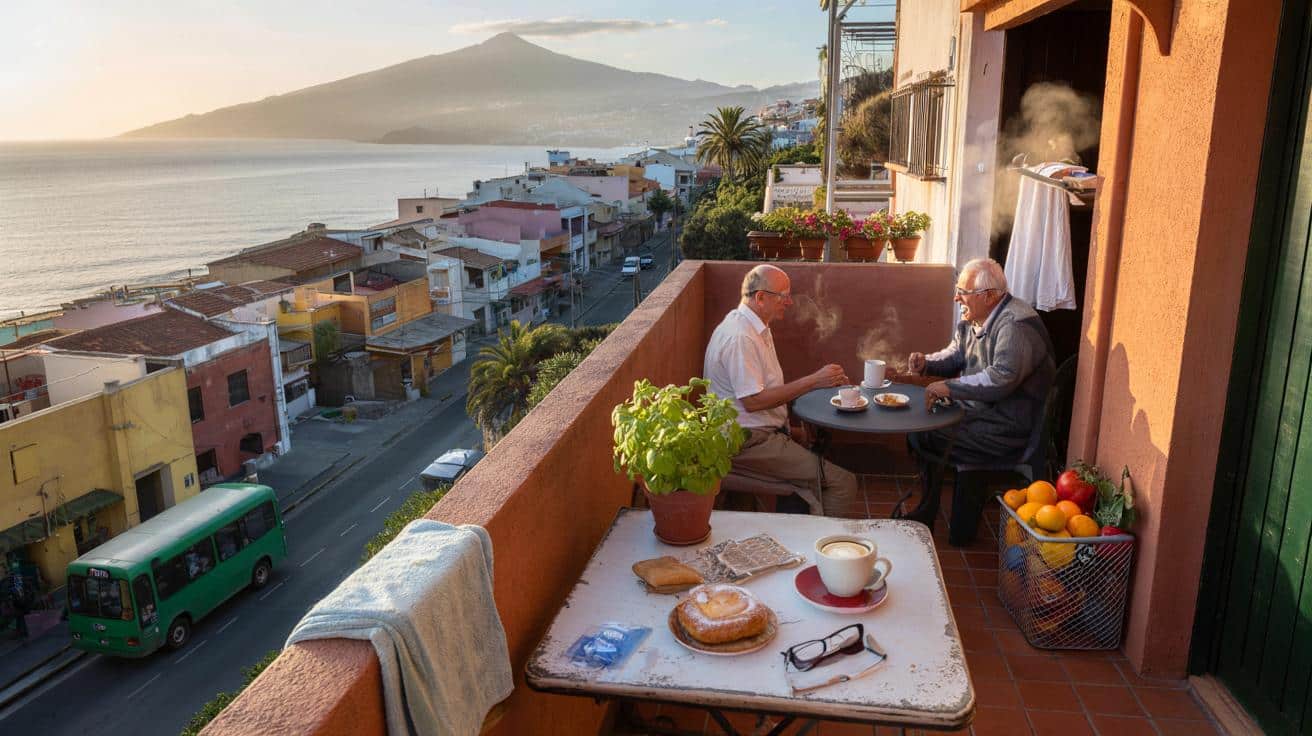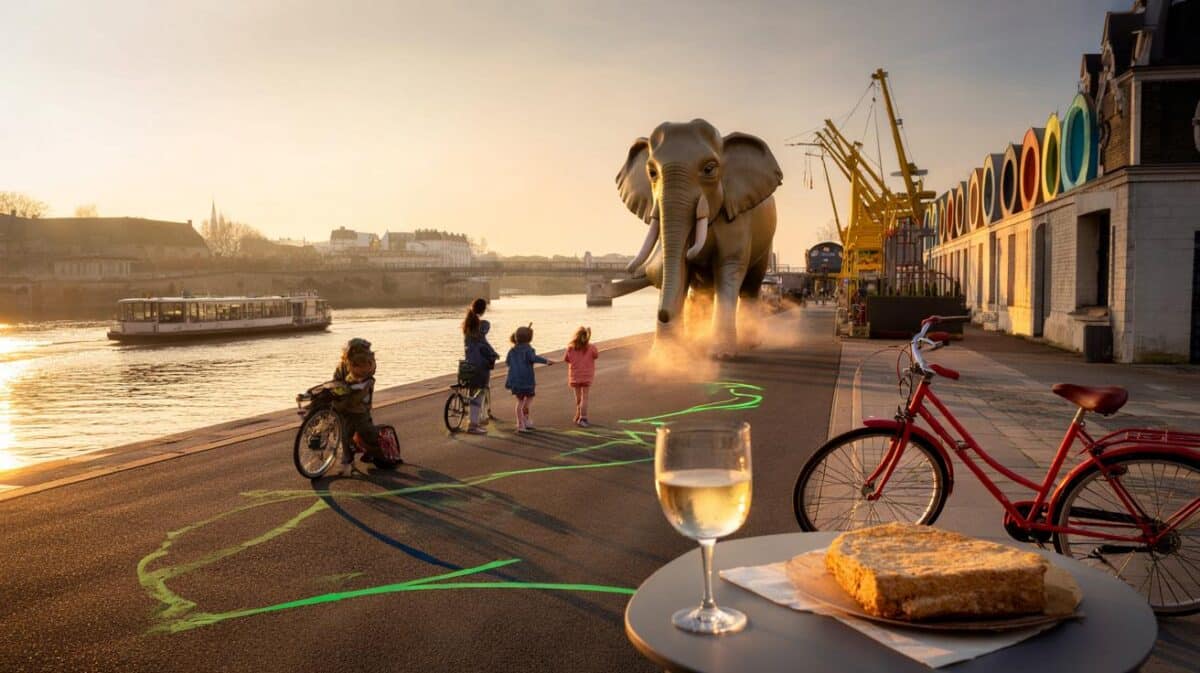Could a month in Tenerife preview the life we dream of after the office keycard stops beeping? I went to find out. Not as a tourist chasing sunsets, but as a would‑be retiree with a budget, a calendar, and a quiet curiosity about what the days actually feel like when your time is your own. The island looked different when I swapped itineraries for routine.
07am in Puerto de la Cruz, the light over the Atlantic looked like hot metal cooling in a forge. A baker slid trays out onto the pavement, steam lifting off sugared pastries, and a group of older men debated football with cups of café con leche balanced on saucers that clinked when they laughed. I rented a small flat up a long hill, the kind that teaches you patience and calves. The sea sounded like a giant breathing in the background. I told myself I was there to test retirement, not to play at holiday. Then the wind changed.
The day-to-day truth of a “retirement month” in Tenerife
The rhythm surprised me. Mornings had a bright, elastic energy, and the island worked like a village with buses. By lunch the air thickened, shutters dropped, and conversations grew slower and softer. I learned the grocery cashier’s name before I learned the tourist board’s slogans. On paper I had all the time in the world, yet the day still wanted structure. My notes read like a tide table: walk early, write a line to someone I love, swim if the flag is green, read under a tree that doesn’t mind the wind.
There were numbers too. My one‑bed rental was €820 for the month, the kind of place where the sofa has seen stories and the balcony fits two chairs and a stubborn pot of basil. Coffee was €1.50 to €2.20 depending on the smile, and a plate of grilled fish and papas arrugadas came in under €14 away from the seafront. The bus with a topped‑up card was around €1.75 within town, and the long green coaches made the whole coastline feel close. I tracked it all like a scientist, then caught myself chatting to the elderly woman who sells oranges by the church.
Holiday mode evaporates when you’ve got a laundry routine. That’s where the test lives. In retirement you don’t fill every day with excursions; you grow a new pattern where chores and tiny pleasures share the same page. Heat dictates tempo. Loneliness taps your shoulder if you don’t say hello. The island offers you spectacle when you ask for it, but what stays is the hum of small decisions: where to buy your bread, which bench has shade at four, whether your Spanish is bad but brave today.
How to run a no‑nonsense retirement trial in Tenerife
Start with a base that isn’t the glossy postcard. I chose a residential street in Puerto de la Cruz rather than a resort, so my neighbours were teachers, gardeners and retired couples who wheeled out their bins on Tuesdays. Set a realistic monthly budget and stick to it for the full four weeks, including little leaks like gelato and taxis up hills when your knees object. Build a weekday routine that mirrors what you imagine later life will be: a morning walk, a practical chore, a social act, a quiet hour.
Don’t sprint your month. The trap is to schedule every caldera and cove as if a guidebook is marking your homework. Let’s be honest: nobody actually does that every day. Visit the market on a Thursday, sit on the tram between Santa Cruz and La Laguna just to watch faces, and try the public pool on a breezy afternoon when the clouds refuse to move. For healthcare peace of mind on a short stay, bring your GHIC card and common sense. For anything long‑term you’d handle it differently, but this month is about feel, not paperwork.
If you like lists, track the real things. I logged steps, spends, and smiles initiated, and the last column taught me the most. I also spoke to Keith, a former electrician from Leeds who has lived in Tenerife for nine winters. He said the secret isn’t sunshine, it’s a reason to leave the house before 10.
“Weather’s lovely, mate, but it’s not a personality. Find your people. Join the walking club or the choir, even if you sing like a radiator.”
- Rent for a modest one‑bed: €750–€950 if you look beyond the beachfront.
- Daily basics: bread €1.40, milk €1, local fruit €0.80–€2 per piece.
- Transport: reloadable bus card, short rides around €1.75; longer trips cost more but feel easy.
- Utilities for a month: variable, but my electric ran €35 with fans not air‑con.
- Social: language exchange nights, €0 entry; a beer €1.50–€3 with snacks that come for free.
What stayed with me after thirty days
My favourite day wasn’t the waterfall or the volcano. It was a Tuesday when nothing special occurred, and yet everything felt placed just right. I walked the coast path before the dog walkers, chatted to Miguel at the greengrocer about tomatoes, and watched schoolchildren race for the tram doors like it was a game they’d invented. We’ve all had that moment when a city gives you a wink and says, “You’ll do.” Tenerife did that in a gentler, saltier dialect. By week four I’d stopped checking the weather and started checking who wanted coffee.
That’s the test. Retirement isn’t about what you can add, it’s about what you can repeat without it dulling. The island had edges: wind that steals your hat, stairs that punish knees, paperwork that speaks serious Spanish. It also had a neighbour knocking on my door with a plate of tortilla because I’d complimented her begonia. I flew home with a journal full of receipts and a new respect for ordinary light through thin curtains. The question isn’t “Could I live here?” It’s “Would I like my Tuesday here?” I think I would, most of the time.
| Point clé | Détail | Intérêt pour le lecteur |
|---|---|---|
| Test the routine, not the sights | Build a weekday pattern you can sustain for months | Shows if the island fits your real life, not your holiday mood |
| Track grounded costs | Rent, groceries, transport, small treats written down | Replaces guesswork with numbers you can plan around |
| Find your people early | Clubs, markets, language exchanges, neighbour chats | Reduces isolation and makes the move feel human |
FAQ :
- Is a month enough to judge retirement life in Tenerife?It won’t answer everything, but it reveals the cadence of days, the cost of basics, and how you feel in the quieter hours.
- Where should I stay for a realistic trial?Pick a residential area like La Laguna, Puerto de la Cruz, or a non‑touristy part of Los Cristianos, close to shops and a bus stop.
- How much should I budget for one month?For a modest one‑bed and simple living, many manage on €1,400–€2,000, depending on rent and how often you eat out.
- What about healthcare during the month?Bring your GHIC for necessary state care on a short stay and keep travel insurance for gaps; long‑term residents handle it differently.
- Will I feel isolated if I don’t speak Spanish?You’ll get by in many areas, but a few phrases open doors. Start with greetings and politeness, then practise daily with locals.









Loved the focus on routine over “sights.” Your Tuesday anecdote hit me—retirement is about repeatable days that don’t dull. The cost breakdown (coffee €1.50–€2.20, bus ~€1.75) is gold for planning, and the note about loneliness tapping your shoulder felt honest. This is the first Tenerife piece that made me picture which bench I’d choose at 4 p.m. Bookmarked.
Quick practical Q: did the €820 one‑bed include utilities, or was that on top of the ~€35 electric you mentioned? And how useful was the GHIC in reality for a month—did you ever need it?